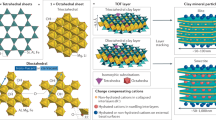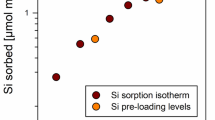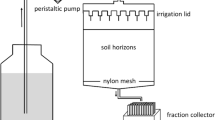Abstract
EARTH scientists have long recognized1á€-4 that the soluble organic acids excreted by soil biota enhance rates of mineral weathering, thereby chemically stratifying the soil and affecting the biodegradation pathways of organic matter, including pollutants5. Multidentate organic ligands6,7 also exist in industrial waste waters8 and can enhance the mobility of heavy elements, including radionuclides9. Here we examine whether rate coefficients for ligand-promoted disolution of minerals can be predicted from existing studies of dissolved metal complexes. We have performed dissolution experiments on bunsenite (NiO) to compare with published studies of ligand exchange around dissolved Ni(II)á€-ligand complexes10á€-12. The hypothesis is confirmed with surprising detail: the dissolution rate coefficient increases with the number of ligand functional groups coordinated to the surface metal, as do the exchange rate coefficients10á€-12. Furthermore, we find that the dissolution rate coefficients can be predicted from the equilibrium constants for metal complexation in solution, indicating that the activated surface complexes resemble the corresponding dissolved complexes in important ways.
This is a preview of subscription content, access via your institution
Access options
Subscribe to this journal
Receive 51 print issues and online access
$199.00 per year
only $3.90 per issue
Buy this article
- Purchase on Springer Link
- Instant access to full article PDF
Prices may be subject to local taxes which are calculated during checkout
Similar content being viewed by others
References
Hilgard, E. W. Soils: their Formation, Properties, Compositions and Relations to Climate and Plant Growth in the Humid and Arid Regions 19 (Macmillan, New York, 1914).
Bloomfield, C. J. Soil Sci. 4, 17–23 (1953).
Powell, P. E., Cline, G. R., Reid, C. P. P. & Szanislo, P. J. Nature 287, 833–834 (1980).
Huang, W. H. & Keller, W. D. Nature 239, 149–151 (1972).
Lovley, D. R., Woodward, J. C. & Chapelle, F. H. Nature 370, 128–130 (1994).
Muir, J. W., Morrison, R. I., Brown, C. J. & Logan, J. J. Soil Sci. 15, 220–225 (1964).
Drever, J. I. & Vance, G. F. in Organic Acids in Geological Processes (eds Pittman, E. D. & Lewan, M. D.) 138–161 (Springer, New York, 1993).
Francis, A. J. Experientia 46, 840–850 (1990).
Means, J. L., Crerar, D. A. & Duguid, J. O. Science 200, 1477–1480 (1978).
Wilkens, R. G. Kinetics and Mechanism of Reactions of Transition Metal Complexes, (VCH, New York, 1991).
Rowland, T. V. thesis, University of California at Berkeley (1975).
Margerum, D. W., Cayley, G. R., Weatherburn, D. C. & Pagenkopf, D. K. Kinetics and Mechanisms of Complex Formation and Ligand Exchange. Ch. 1 (ACS Monogr. 174, Am. Chem. Soc. Washington DC, 1978).
Furrer, G. & Stumm, W. Geochim. cosmochim. Acta 50, 1847–1860 (1986).
Pohlman, A. A. & McColl, J. C. J. envir. Qual. 14, 86–92 (1986).
Burgess, J. Metal Ions in Solution 333 (Ellis-Horwood, Chichester, 1990).
Martell, A. E. & Smith, R. M. Critical Stability Constants Vols 1–6 (Plenum, New York 1975–89).
Westrich, H. R., Cygan, R. T., Casey, W. H., Zemitis, C. & Arnold, G. W. Am. J. Sci. 293, 869–893 (1993).
Kummert, R. & Stumm, W. J. Colloid Interface Sci. 75, 373–385 (1980).
Casey, W. H. & Westrich, H. R. Nature 355, 157–159 (1992).
Oreskes, N., Shrader-Frechette, K. & Belitz, K. Science 263, 641–646 (1994).
Sverjensky, D. Nature 358, 310–313 (1992).
Author information
Authors and Affiliations
Rights and permissions
About this article
Cite this article
Ludwig, C., Casey, W. & Rock, P. Prediction of ligand-promoted dissolution rates from the reactivities of aqueous complexes. Nature 375, 44–47 (1995). https://doi.org/10.1038/375044a0
Received:
Accepted:
Issue Date:
DOI: https://doi.org/10.1038/375044a0
This article is cited by
-
Ab initio mechanism revealing for tricalcium silicate dissolution
Nature Communications (2022)
-
Organic ligand induced release of vanadium from the dissolution of stone coal oxide ore
Environmental Science and Pollution Research (2019)
-
Exposure media a critical factor for controlling dissolution of CuO nanoparticles
Journal of Nanoparticle Research (2018)
-
Mesoscopic architectures of porous coordination polymers fabricated by pseudomorphic replication
Nature Materials (2012)
-
Adsorption of hydroxamate siderophores and EDTA on goethite in the presence of the surfactant sodium dodecyl sulfate
Geochemical Transactions (2009)
Comments
By submitting a comment you agree to abide by our Terms and Community Guidelines. If you find something abusive or that does not comply with our terms or guidelines please flag it as inappropriate.



